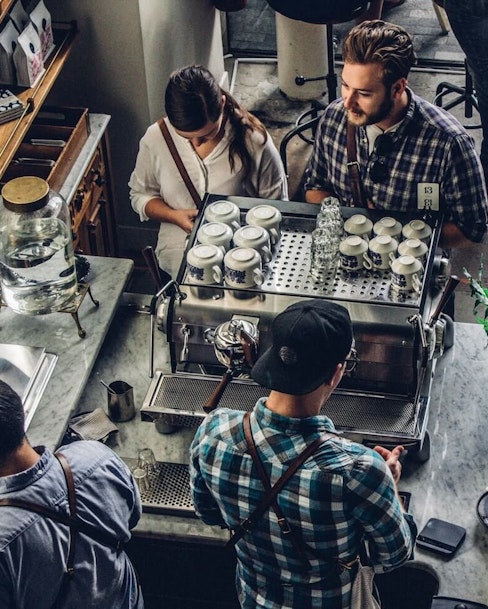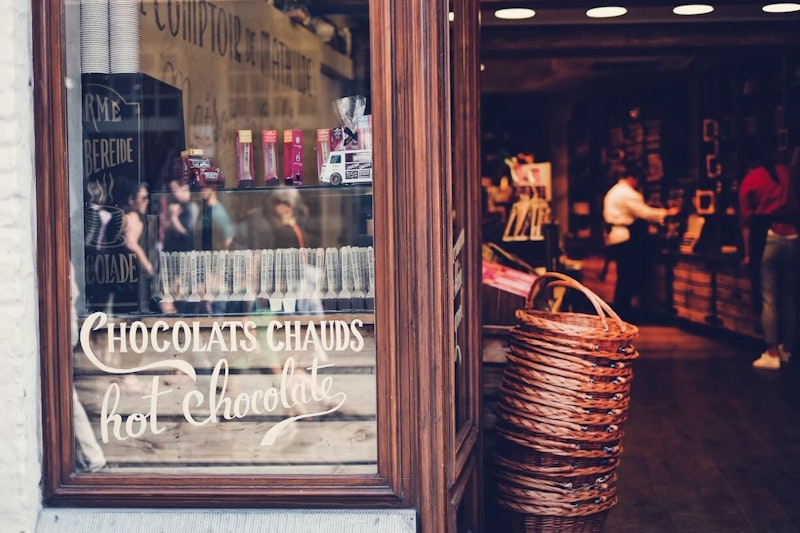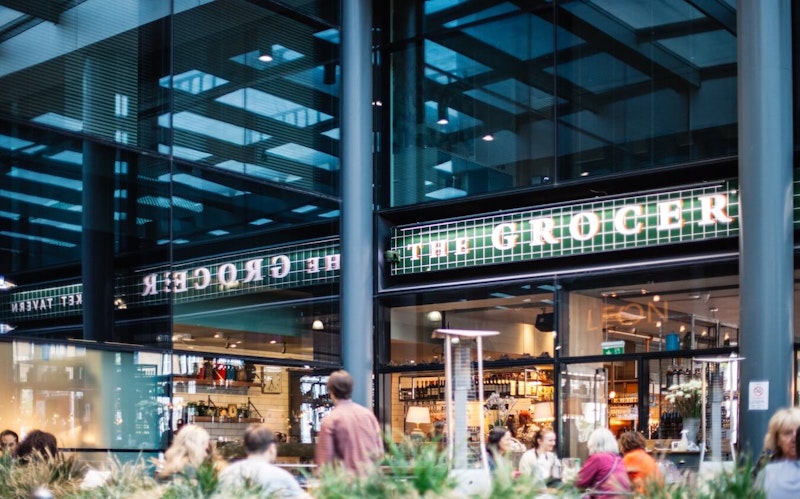Blog
Use music to design a better customer experience

In a business climate increasingly dominated by online sales, smarter music choices can enhance in-store experiences that resonate with customers.
Posted on February 19, 2022
What do a Philadelphia grocery store and a women’s boutique shop in New Orleans have in common? Both of these businesses use music as a powerful tool to engage customers and inform the physical spaces they work in. We all know lighting, interior design and furniture play a part in shaping where we live, shop and work every day, but whether we realize it or not, sound and music can dramatically change the way we interpret a space––and smart businesses of every stripe are taking notice.
Matching the personality of your business with the right music can boost profits and carve out an identity for your brand at the same time, but it’s no easy task. With its ability to decorate a space through the story of sound, music introduces new ideas and reinforces previous notions and expectations about the area it’s being played in. But because music trends and tastes are ever-evolving, it can be difficult to know what sort of music will resonate with your customers.
“Matching the personality of your business with the right music can boost profits and carve out an identity for your brand at the same time, but it’s no easy task.”
Nonetheless, some aspects of music’s effect on consumers are predictable. Studies show that playing music at fast or slow tempos has a big impact on a customer’s actions. According to an article written by the marketing research firm MotiveMetrics Research, “Fast music leads to high levels of arousal which, in turn, leads to (customers) moving at a faster pace through the store. Conversely, music with slower tempos prevents these high levels of arousal and slows down the pace at which shoppers move, leading to an increase in items purchased.” The article goes on to explain how loud music can drive customers away from stores.
But while tempo and volume can inspire somewhat predictable and easy to measure customer attitudes and actions, how musical genre, style and sound itself shapes spaces is a different animal entirely.
The evolutionary importance of sound
To learn more, I interviewed Niklas Alvarsson, Design Director for Soundtrack Your Brand. According to Niklas, not just music but sound, in general, is a crucial part of designing a space in a way to connect with customers. “Sound is the first sense humans use to orchestrate all the other senses,” says Nicklas. “It goes back to the way we evolved to survive in dangerous environments. Sound was crucial to our ancestors because it meant the difference between being able to detect threats or not.” At the most basic human level, how spaces sound to us dictates how we feel about them.
“When you look into a department store window display during the holidays,” Niklas went on, “special holiday music or even the sound of a person’s voice narrating the scene has the power to draw people in and make them a part of the experience.” But the physical spaces affected by sounds aren’t just limited to storefronts and other places of business.

“With retailers having to compete with internet behemoths like Amazon, getting the sound and music elements of customer experiences right has never been more critical.”
In a fascinating article published by Fastcodesign.com, author Yasushi Kusume argues that sound plays an important role in spaces such as the cars we drive. “The sound of a closing car door is the most well-known and frequently used example of a sensorial design approach. Many of the top automobile brands have separate door development teams, with design engineers dedicated to fine-tuning their particular–signature–door-closing sound. With the sound of their car doors, Mercedes have built two layers of values into one message. The first is the brand level, the second a category value proposition. For instance, the doors of Mercedes SUVs have been tuned to sound heavier, in a bid to communicate their robustness.
The automobile industry provides some of the most advanced examples of sensorial design.”
Other companies wield the absence of sound to shape spaces that meet customer needs. Hästens, the luxury Swedish bed company, invites customers to nap on their beds during store hours in small, silent rooms located in their larger showrooms. Working in tandem with design, lighting and furniture elements, Hästens uses silence as a tool to curate immersive experiences for their customers. Whether it’s luxury beds or fancy SUVs, businesses are using multisensory experiences to connect with customers.
The way to compete with online (and why it works)
With retailers having to compete with internet behemoths like Amazon, getting the sound and music elements of customer experiences right has never been more critical. To contrast and compete with purely digital shopping experiences, companies like IKEA are investing in smaller showrooms where customers can experience products firsthand and then get them delivered after purchasing. Additionally, the iconic Swedish home furniture company recently announced a partnership with the audio company Sonos to “democratize music and sound in the home.” IKEA is investing not only in shaping the sound of its showrooms but also the homes of its customers.
An integral part of a business effectively shaping a space through music is having an intimate knowledge of what drives its customers. Get it right, and you’ll have a proven method of creating a space your customers will want to be in, but that’s not always easy.
I distinctly remember avoiding shopping in a grocery store in my old neighborhood because of the music it played, which was generic playlists of upbeat songs with lyrics about happiness and the world being peachy-keen. I perceived the music to be corny and ingenuine at best and even a bit infuriating at times, and it bothered me so much so that I would avoid the store entirely even though it was the closest one to my house. The music selections were clearly deliberate, but had the opposite of the intended effect on me.

So, how can businesses get it right? For niche businesses, narrow music selections work, but it’s a much tougher task when it comes to selecting music for businesses that cater to a wider net of customers.
Soundtrack combines human curation and sophisticated algorithms to help brands find their musical identities. To put it simply, Soundtrack has mastered the delicate art of matching a brand with the right music by using models based on behavior values like tech vs. human or timber vs. steel. These values are based on extreme characteristics of the brand, which is given multiple tiers of service options once it’s been appropriately matched with five songs that will determine future playlists and scheduling.
To learn more about how brands use music to shape their physical storefronts, I profiled two different American places of business.
Saint Claude Social Club
New Orleans, United States
Saint Claude Social Club is a chic, Haitian and African-inspired women’s boutique shop located in New Orleans, Louisiana. Featuring one-of-a-kind offerings from independent female clothing and jewelry designers from around the world, Saint Claude is a unique, progressive brand. Music reflecting the eclectic celebratory nature of New Orleans is an integral part of the brand.
“Music is a big part of the environment that we have created as music is a part of life in New Orleans,” Saint Claude Social Club says. “We’ve created a warm, inviting women’s parlor atmosphere at Saint Claude Social Club and we want the music to tell a story along with our merchandise mix. At SCSC, we carry an array of merchandise we’ve sourced around the globe that tells a story about New Orleans style and culture: soulful, rich, layered, fun, eclectic and unique. We choose music that goes along with that. Our customer mix is half tourist and half local, and we want our visitors to feel happy, comfortable and inspired by the music. Therefore, we don’t like to play genres of music that are too specific and recognized.”
Riverwards Produce
Philadelphia, United States
Born out of a Philadelphia neighborhood pop-up garage store that sold fresh produce in 2016, Riverwards Produce scaled up to a bricks and mortar storefront to meet overwhelming customer demands soon after. The name “Riverwards” refers to a section of north Philadelphia’s river-facing industrial neighborhoods, and the ambitious new store boasts a thoughtful, stylish atmosphere without forgetting where it came from and the community it serves.
“We take the same approach to picking our music as we do when deciding our produce and product variety,” says Riverwards. “We assume that if we think something is cool, our customers will too. The music can range anywhere from West African Funk to 90s College Rock to Elvis. The music rarely serves as simple background filler. Everyone in the store has strong feelings about what gets played.”
Instant Replay Summary
The sound of an environment has a direct evolutionary impact on how we feel about it.
Matching the right sounds and music to a physical space leads to higher customer engagement and increased profits, but playing the wrong sort of music could have the opposite effect.
In a business climate that’s increasingly dominated by digital sales, in-person experiences in storefronts and showrooms are more crucial than ever. Music and sound selections are ways to create immersive experiences that will resonate with customers.
Soundtrack can match brands with music their customers will relate to. Using a nifty system of human curation, analytics, and algorithms, Soundtrack helps boost profits by helping companies to get the music and sound element of the physical spaces they do business in right.
Ready to get started?
See how Soundtrack works for you and your business. Get our most exclusive features with a no obligation 14 day trial, unlocking everything available in Soundtrack Unlimited.
Related articles

Enterprise Music RFP: Choosing a Commercial Music Service

Apple Music for Business is Gone (Use This Alternative)

Bar and Restaurant Revenue Statistics, Trends, and Predictions

15 Ways to Increase Restaurant Sales and Customer Retention

What Is a Public Performance License? Everything You Need to Know

5 Music Apps for Bars and Restaurants